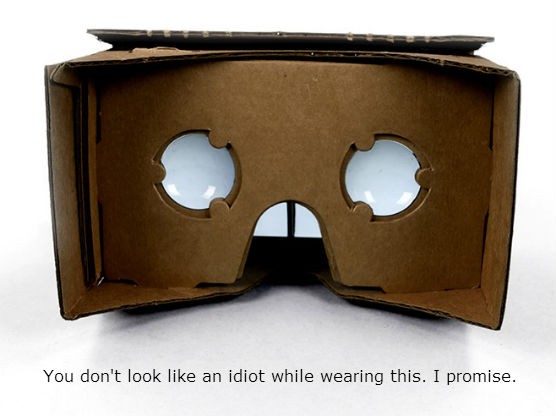
To some, the very idea of virtual reality or augmented reality is something way off in the future. Not something to even give thought to right now.
But Google has put in the hands of the people an example of the early capabilities of virtual reality. Something that anyone can physically get a hold of. Something that can be experienced through a free app and some cardboard which you can obtain from nothing more than a pizza box if you fancy it. (Great excuse to have pizza, and you can blame the Cardboard’s inevitable forehead grease patch on the greasy pizza box – we won’t tell, we promise!)
How Do I Make A Google Cardboard Virtual Reality Headset?
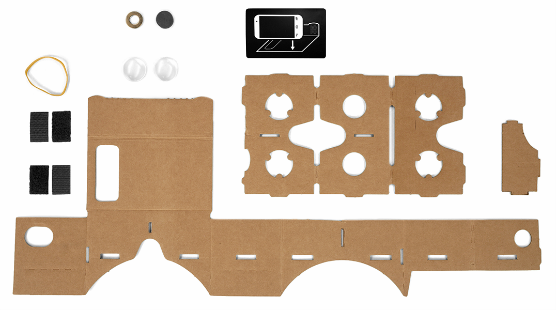
^ This. This is all you need. Or you could do what I did and order a pre-cut cardboard flat pack, with lenses, magnets and Velcro included, from China for £3 with free shipping. I kid you not. (Be prepared to wait a month if this sounds like the plan for you.)
Though Google are encouraging people to get creative and construct their own, what they’re really encouraging is people to construct these in bulk so that they can sell them from China for £3 a piece – or £20 if you want to buy it from Amazon and have it delivered the next day. Either way, you’re either paying excessively or waiting excessively for a bit of cardboard that you then have to fold yourself. I know, right.
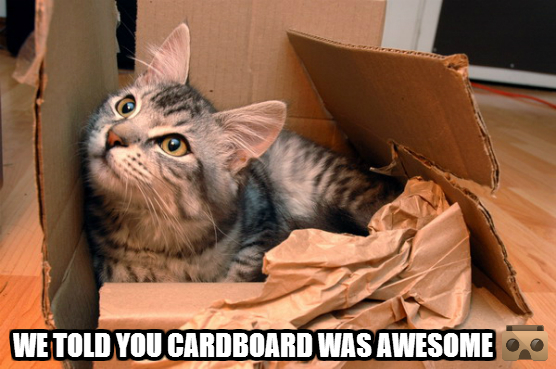
So with cats everywhere arrogantly meowing at us, “we told you so, we told you so!”, what awesome things can we actually do with Cardboard?
There are already a number of apps available online for free download, including Google’s own Google Cardboard app, and companies are jumping in on the growing trend, trying to get in on the action early by developing a virtual reality app while virtual reality content is still currently lacking. This month alone there have been a few high-profile new Google Cardboard app releases. John Lewis have turned their recently popular Monty the Penguin into a Monty’s Goggles Google Cardboard app (6th November 2014), Volvo have created a Google Cardboard app that allows users to test drive their upcoming Volvo XC90 SUV in a virtual reality (18th November 2014), and even Paul McCartney knows where Google Cardboard’s at with an app released yesterday allowing you to experience “Live and Let Die” on-stage with him within a fully 3D concert (20th November 2014). So whether you want to play with cartoon penguins, drive the new Volvo or hang out with Paul McCartney on stage, backstage or from the crowd during San Francisco’s Candlestick Park, it’s clear to see the direction in which virtual reality is going as a marketing tool.
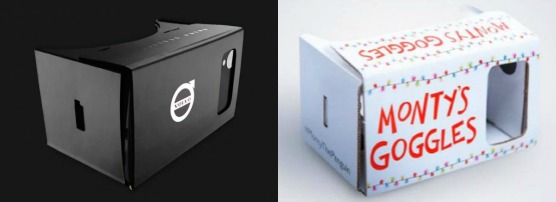
Volvo and John Lewis’ own branded Google Cardboard headsets.
Google Cardboard: Virtual Reality or Augmented Reality?
It really depends on how you use Google Cardboard and what you are able to do with Google Cardboard in the future. Basically, the key difference between virtual reality and augmented reality is whether you’re interacting with a virtual world (virtual reality) or blending 3D virtual elements with real life (augmented reality).
For example, the future of Virtual Reality Marketing (VR Marketing) and Augmented Reality Marketing (AR Marketing) could be the difference between either developing an ecommerce app that allows you to walk around a virtual online store and inspect products in 3D or an ecommerce app that allows you to test products in your own environment. For example, you could be in a fully virtual ecommerce environment, interacting with products as you would in a real life shop. Or you could take a 3D photograph of your living room and test different sofas within a range, seeing how each one would look as you walk around your living room. Either way, I expect that the future of online shopping will be a fully immersive and personal experience.
What is the point of Google Cardboard?
Google unleashed Google Cardboard at the Google I/O 2014 conference earlier this year, demonstrating that anybody with a smartphone will be able to have access to the exciting world of virtual reality without spending huge sums of money on a virtual reality headset. They have stated that “this is just a placeholder. This is a piece of cardboard.” And though a rather rudimentary submission to the line of upcoming virtual reality products, Google knows that timing is everything in a world where content is king. By entering the virtual reality race early, they are firmly establishing themselves in the virtual reality market while the market is still quite non-competitive. Like the brands and developers who are quickly creating apps to be used with the Google Cardboard, knowing that the market has yet to become diluted and people are still Googling for the top Google Cardboard apps. And honestly, there’s currently not a lot out there.
Some have entertainingly nicknamed Google Cardboard as the “Oculus Thrift” – a play on the highly anticipated Oculus Rift virtual reality headset that was bought by Facebook earlier this year, and has dominated virtual reality tech news for well over two years. However the consumer version still isn’t due out until 2015 and even then the cost of the virtual reality head-mounted display still makes the gadget far beyond reach for most people. Though Google’s flat pack virtual reality alternative to the Oculus Rift is admittedly a bit of a gimmick, it’s a cleverly cheap hack at hitting a wide audience with an insight into the capabilities of virtual reality before the Oculus Rift is able to.
So what have Silkstream been doing with Google Cardboard?
Exploring space and riding roller coasters mainly.
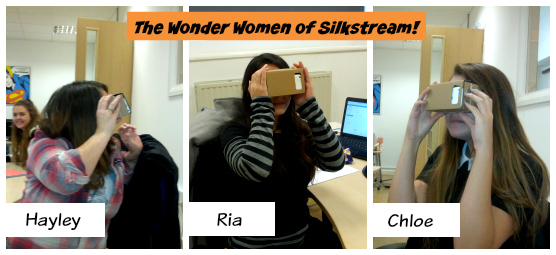
And Silkstream’s Super Men….
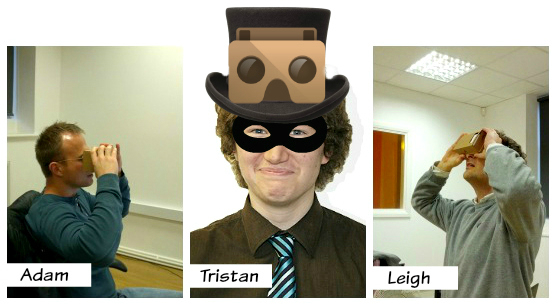
(Tristan has to wear the Cardboard Hat of Shame, since he’s not in the office this week.)

